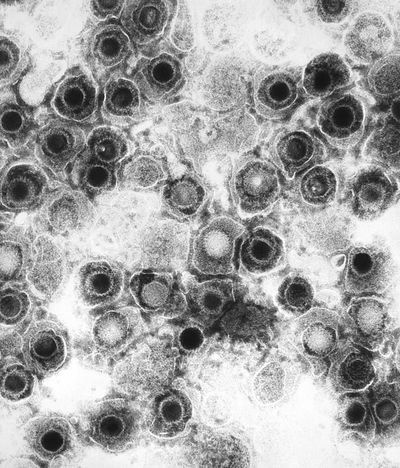Herpes Simplex Virus and Cancer: Difference between revisions
No edit summary |
No edit summary |
||
| Line 2: | Line 2: | ||
Herpes Simplex Virus 1, also known as oral herpes, is responsible for causing sores in the mouth and lip region when infected[http://www.webmd.com/genital-herpes/pain-management-herpes: <sup>1</sup>]. It can be spread by oral secretions such as kissing and sharing objects that have contact with saliva[http://www.webmd.com/genital-herpes/pain-management-herpes: <sup>1</sup>]. It is estimated that up to 90% of people in the United States have had contact with HSV-1 by the age of 50[http://www.hopkinsmedicine.org/healthlibrary/conditions/oral_health/mouth_infections_85,P00888/: <sup>2</sup>]. The virus has the ability to lay dormant for some time in the nerve cells until it gets triggered again, forming somewhat painful lesions[http://www.webmd.com/genital-herpes/pain-management-herpes: <sup>1</sup>] that last two to three weeks[http://www.emedicinehealth.com/oral_herpes/page3_em.htm: <sup>4</sup>]. There is no cure for Herpes, however there are treatments that allow for the lessening of these lesions and pain that are typical of patients with the HSV virus[http://www.webmd.com/genital-herpes/pain-management-herpes: <sup>1</sup>].[[Image:Herpes Gingivalis.tiff|Herpes Gingivalis|right|300px|thumb| HSV-1 virus present on the gums of a patient.]] | Herpes Simplex Virus 1, also known as oral herpes, is responsible for causing sores in the mouth and lip region when infected[http://www.webmd.com/genital-herpes/pain-management-herpes: <sup>1</sup>]. It can be spread by oral secretions such as kissing and sharing objects that have contact with saliva[http://www.webmd.com/genital-herpes/pain-management-herpes: <sup>1</sup>]. It is estimated that up to 90% of people in the United States have had contact with HSV-1 by the age of 50[http://www.hopkinsmedicine.org/healthlibrary/conditions/oral_health/mouth_infections_85,P00888/: <sup>2</sup>]. The virus has the ability to lay dormant for some time in the nerve cells until it gets triggered again, forming somewhat painful lesions[http://www.webmd.com/genital-herpes/pain-management-herpes: <sup>1</sup>] that last two to three weeks[http://www.emedicinehealth.com/oral_herpes/page3_em.htm: <sup>4</sup>]. There is no cure for Herpes, however there are treatments that allow for the lessening of these lesions and pain that are typical of patients with the HSV virus[http://www.webmd.com/genital-herpes/pain-management-herpes: <sup>1</sup>].[[Image:Herpes Gingivalis.tiff|Herpes Gingivalis|right|300px|thumb| HSV-1 virus present on the gums of a patient.]] | ||
Kaposi sarcoma is a type of cancer that can be formed in the lining of the mouth, nose, throat and lymph nodes [http://www.webmd.com/hiv-aids/guide/aids-hiv-opportunistic-infections-kaposis-sarcoma__: <sup>3</sup>]. Kaposi sarcoma was very common in men of Middle Eastern descent but has now been shown to be common in AIDS patients[http://www.webmd.com/hiv-aids/guide/aids-hiv-opportunistic-infections-kaposis-sarcoma__: <sup>3</sup>]. However, it has been shown that Kaposi sarcoma is now caused by the Herpes Virus, and the HSV-1 virus also plays a role in the formation of this cancer. | Kaposi sarcoma is a type of cancer that can be formed in the lining of the mouth, nose, throat and lymph nodes [http://www.webmd.com/hiv-aids/guide/aids-hiv-opportunistic-infections-kaposis-sarcoma__: <sup>3</sup>] and it characterized by purple or red spots on the skin[http://www.nhs.uk/conditions/Kaposis-sarcoma/Pages/Introduction.aspx: <sup>5</sup>]. Kaposi sarcoma was very common in men of Middle Eastern descent but has now been shown to be common in AIDS patients[http://www.webmd.com/hiv-aids/guide/aids-hiv-opportunistic-infections-kaposis-sarcoma__: <sup>3</sup>]. However, it has been shown that Kaposi sarcoma is now caused by the Herpes Virus, and the HSV-1 virus also plays a role in the formation of this cancer. | ||
Revision as of 09:49, 24 March 2015
Herpes Simplex Virus 1, also known as oral herpes, is responsible for causing sores in the mouth and lip region when infected1. It can be spread by oral secretions such as kissing and sharing objects that have contact with saliva1. It is estimated that up to 90% of people in the United States have had contact with HSV-1 by the age of 502. The virus has the ability to lay dormant for some time in the nerve cells until it gets triggered again, forming somewhat painful lesions1 that last two to three weeks4. There is no cure for Herpes, however there are treatments that allow for the lessening of these lesions and pain that are typical of patients with the HSV virus1.
Kaposi sarcoma is a type of cancer that can be formed in the lining of the mouth, nose, throat and lymph nodes 3 and it characterized by purple or red spots on the skin5. Kaposi sarcoma was very common in men of Middle Eastern descent but has now been shown to be common in AIDS patients3. However, it has been shown that Kaposi sarcoma is now caused by the Herpes Virus, and the HSV-1 virus also plays a role in the formation of this cancer.
This means that up to 90% of people with HSV-1 have the possibility to develop Kaposi Sarcoma!
HSV-1
Structure and Evolution of HSV-1
Replication of HSV-1
Clinical Characterization of HSV-1
At right is a sample image insertion. It works for any image uploaded anywhere to MicrobeWiki. The insertion code consists of:
Double brackets: [[
Filename: Ebola virus 1.jpeg
Thumbnail status: |thumb|
Pixel size: |300px|
Placement on page: |right|
Legend/credit: Electron micrograph of the Ebola Zaire virus. This was the first photo ever taken of the virus, on 10/13/1976. By Dr. F.A. Murphy, now at U.C. Davis, then at the CDC.
Closed double brackets: ]]
Other examples:
Bold
Italic
Subscript: H2O
Superscript: Fe3+
Overall paper length should be 3,000 words, with at least 3 figures with data.
Genetic Makeup of HSV-1
Karposi Sarcoma
Include some current research in each topic, with at least one figure showing data.
Genome of Kaposi Sarcoma
Proteins involved in formation
HSV-1 and Kaposi Sarcoma
Include some current research in each topic, with at least one figure showing data.
Pathway to Cancer by HSV-1
Further Reading
[Sample link] Ebola Hemorrhagic Fever—Centers for Disease Control and Prevention, Special Pathogens Branch
References
Edited by (your name here), a student of Nora Sullivan in BIOL168L (Microbiology) in The Keck Science Department of the Claremont Colleges Spring 2014.

